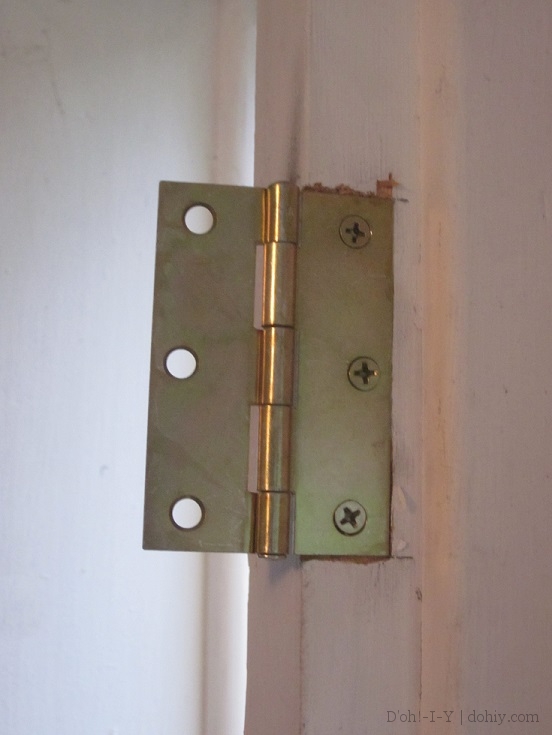Ned: You’re using my table saw to violate a court order?
Homer: Well, we tried all those other tools.
– The Simpsons
We’re putting a new porch door on the front of the house. Stacey mentioned this when she was writing about our plans for the porch, and I wrote about picking up the door. It’s a wooden combination storm door, which will replace an old vinyl-clad model.
The current porch door swings outwards, and is quite effective at brushing trick-or-treaters back off the top step. To avert this kind of Halloween chaos, the new door will swing inwards. The new door should also fit within the existing frame, because that’s just easier.
The door was almost ½” wider than the opening, so we cut ¼” off both sides with the table saw. Now it fits in the frame.
Now I can start hanging the door. The main consideration when hanging the door was to make sure there was enough clearance at the bottom for a mat.
The floor slopes away from the house. This was for drainage back when the porch was unglazed. (Yes, that’s right, our porch is now covered in frosting! No it’s not. It has windows with glass in them, and that’s glazing where I come from.) When the door is open, the gap under the door is largest at the hanging end and smallest at the up-slope, swinging end. The point of smallest clearance is the one of greatest concern. This meant trimming the top of the door to allow for a large enough gap at the bottom. For our installation, we ended up taking off about ¾”.
With the door trimmed and in place, I marked the position of the hinges on both door and frame. The distances from the top and bottom of the door to the respective hinges should not be equal, because it won’t look right. The distance from the bottom of the door to the bottom hinge should be bigger than that distance at the top. To get an idea where to place hinges, you can measure one of your own interior doors and make your hinges match.
With the hinge positions marked, I used a chisel to cut mortises for the hinges on the frame. You want it to be just deep enough for the hinge leaf to be flat with the wood. If you go too deep, you can shim it, but try not to go too deep.
Once the hinge side was chiseled properly, I screwed the hinges to the frame and popped the door back in to recheck the hinge marks on the door. Then, I cut mortises for the hinges on the door and attached the hinges. Once the hinges were reattached to the frame, the door was hung.
Now to fill in that gap at the top of the door. The gap measured 1″ x 5/8″, so we bought a 1″ square dowel and ripped it down to 5/8″ on the table saw.
The brad nailer came in handy for attaching the strip to the top of the door. Then the joints were filled with wood filler.
With the top of the door fixed, I set about fitting the mail slot (or letter box for UK readers).
There was a bit of a problem when it came to deciding where to put the mail slot. The frame of the door is 1″ thick, solid wood, but the panels are ¼” and made of some kind of composite. Our first thought was to put the mail slot on a cross member, but it wasn’t wide enough. It has to go in the top panel. But the mail slot attaches with screws into the door, and the thin, composite material wouldn’t hold screws.
The answer we came up with was to glue pieces of ½” plywood inside the panels on the interior side of the door. This leaves the paneling intact on the exterior side. Now, the mail slot screws will have something to get their teeth into. Obviously, the gap for the mail slot has to go through both layers.
As well as cutting a gap the size and shape of the opening in the hardware, it is also necessary for this model to make cutouts where the hinge mechanism sticks out. (Most mail slots come with a template, but not this one.)
Once the holes were the right size I liberally applied glue to the door and the pieces of plywood and stuck them in. Before the glue set, I attached the mail slot with the studs provided to ensure the holes were lined up correctly. Clamps held both panels in place until set.
So there, the hinges, mail slot and panels are fitted. Now we have to attach the rest of the hardware (locks and door knobs and weatherstripping), then sand, prime and paint the door. I wonder if it’ll get done by Halloween, or if we’ll be sweeping toddlers off our top step for one last year.











